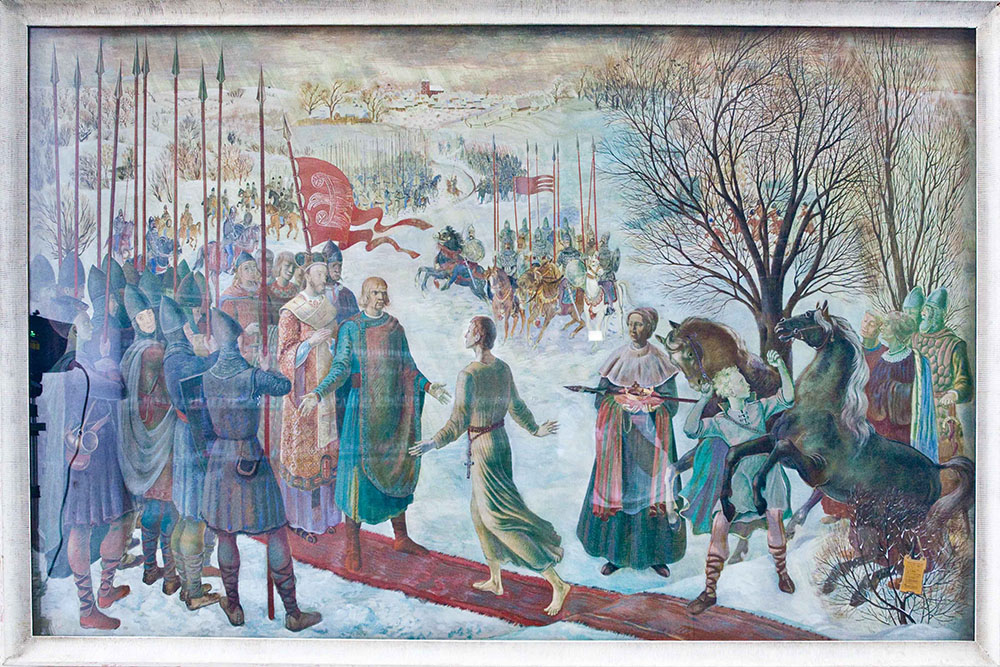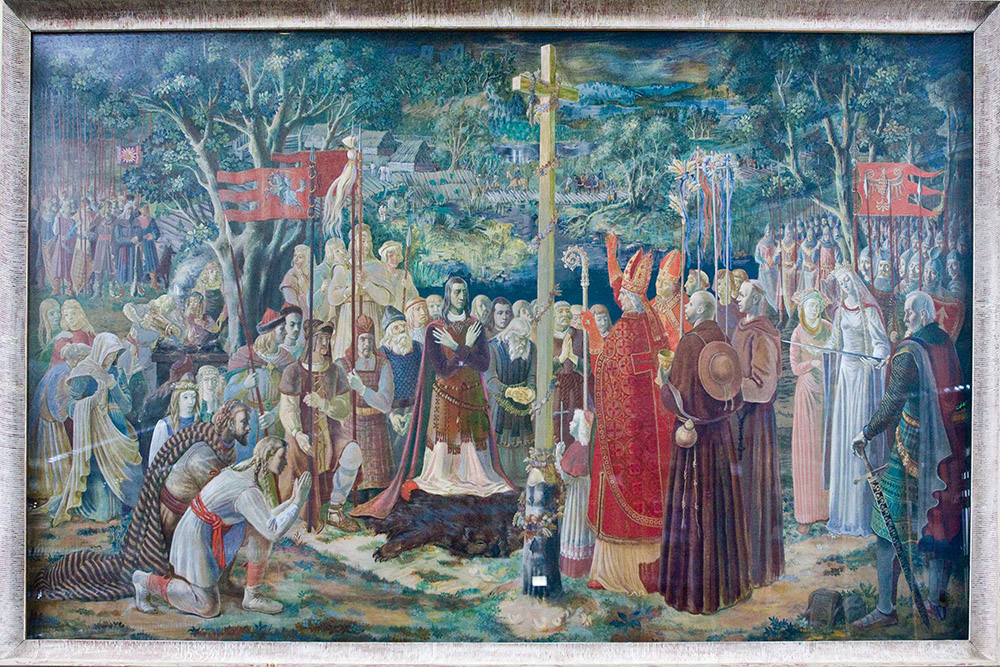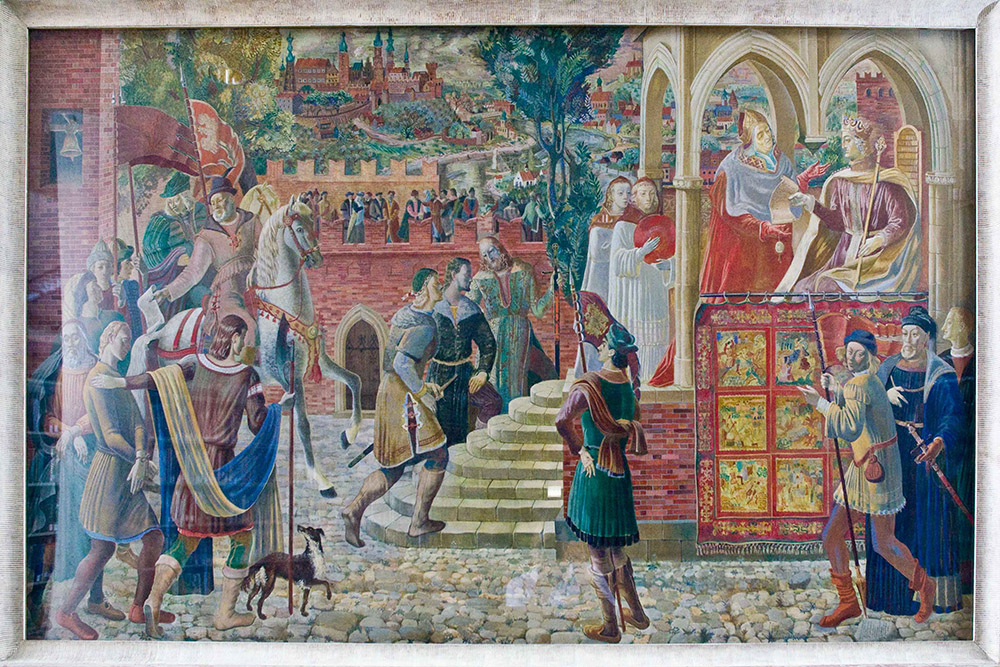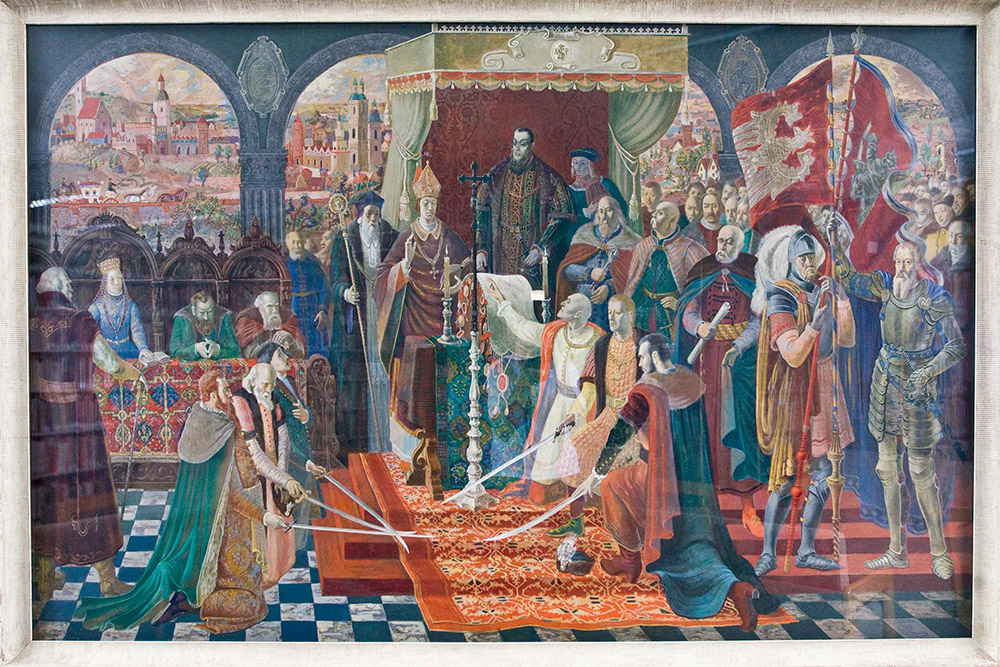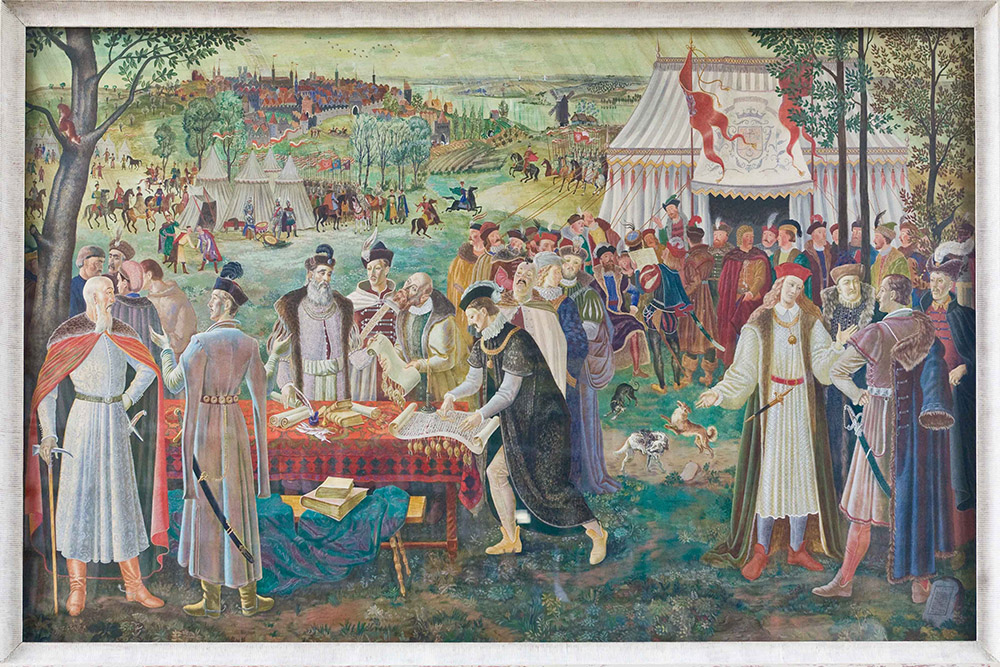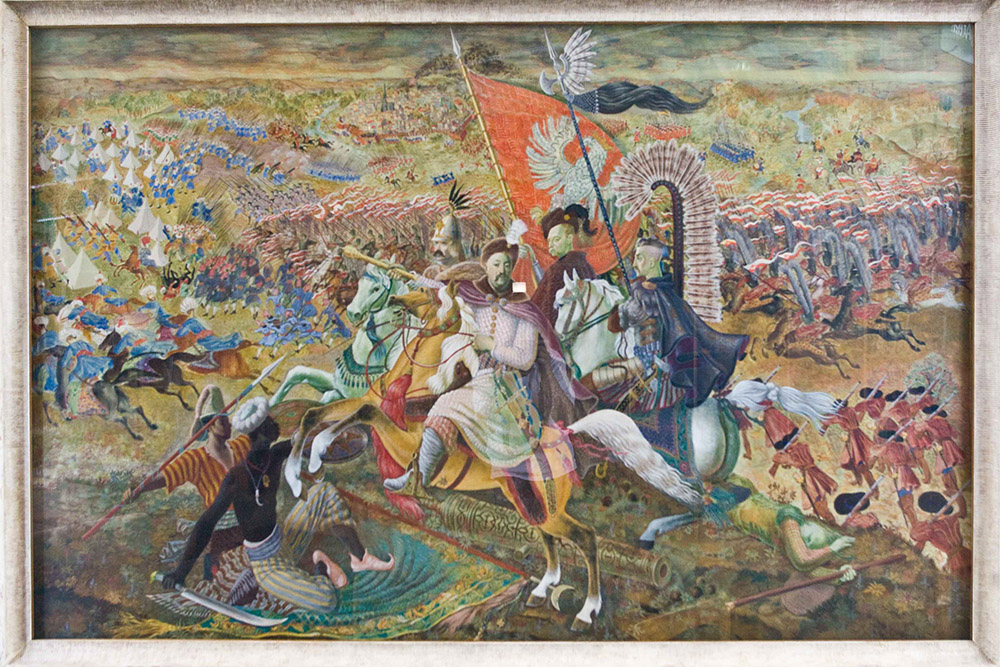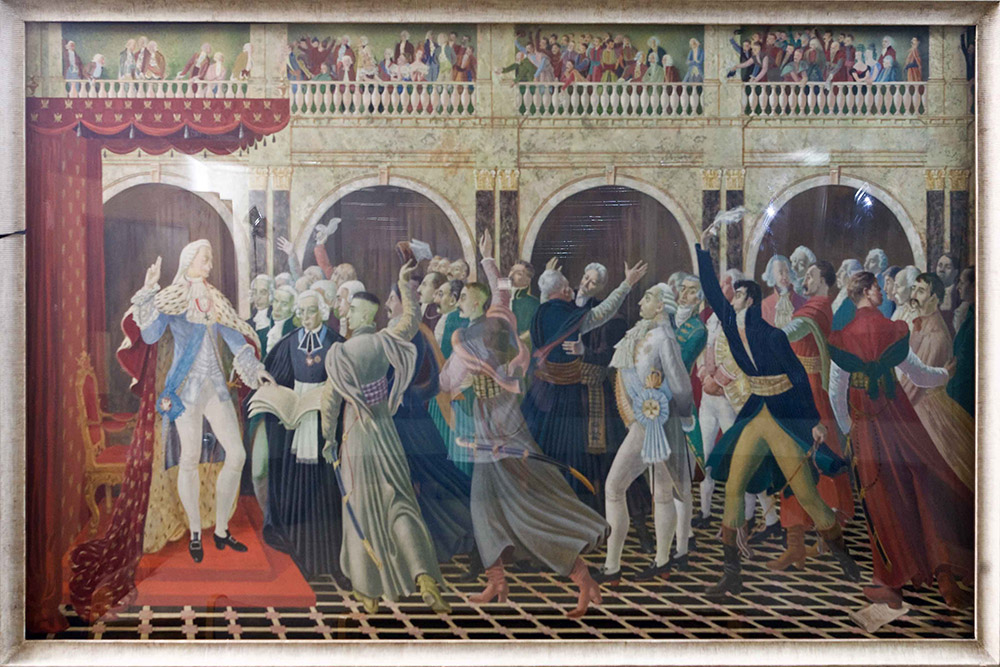The pavilion planned for the New York World's Fair was designed by a committee that consisted of a select group of Poland's finest artists and architects. Their aim was to present Poland as a modern country with a long history, a people who had a place within the fraternity of nations. Chosen as Commissioner General to manage the pavilion exhibit was Stephen de Ropp, who already had extensive experience from his directorship of the annual Poznan Trade Fair.
The pavilion, built on Flushing Meadows was a very fine example of early twentieth century modernistic architecture. There was also a separate building housing a Polish-cuisine restaurant, where waitresses in folk costume served customers. In front was a spectacular 50 meter (142 foot) lattice tower covered with shield-like crests, suggesting a medieval fortress. Pools ran alongside to form a symbolic moat. This imposing facade served as a backdrop to an equestrian stature of Poland's warrior-king Wladyslaw Jagiello. The fact that under Jagiello's leadership, Lithuanian and Polish forces dealt a decisive blow to the encroaching power of the Teutonic Knights in 1410 was not lost on the German visitors to the fair.
Within, the latest and brightest of Poland's technological achievement was displayed to fit into the fair's World of Tomorrow theme. No effort was spared in providing the best examples among Poland's industrial products and inventions. Notable among these were two scale models of steam locomotives that reflected current Polish production. They were meticulously crafted and each was a tour-de-force of the model-maker's art with every rivet, valve and gear faithfully rendered.
An article in the New York Times from May 19, 1939 waxed poetic in describing some of the industrial, cultural and historical displays of the pavilion. The participation of Kosciuszko and Pulaski in the American Revolutionary War was mentioned, as well as the statistic that 5 million Americans were of Polish background.
Chief among the historically themed exhibits in the Hall of Honor within the pavilion were seven paintings that portrayed pivotal scenes from Polish history. These were 120 by 200 cm tempera paintings on wood, executed in a pre-Raphaelite style that was reminiscent of medieval painting. They were a group project commissioned by the Polish government from the Brotherhood of St. Luke, a group of artists assembled by Tadeusz Pruszkowski in Kazimierz on the Vistula. The artists were: Boleslaw Cybis, Bernard Frydrysiak, Jan Gotard, Aleksander Jedrzejewski, Eliasz Kanarek, Jeremi Kubicki, Antoni Michalak, Stefan Pluzanski, Janusz Podoski and Jan Zamoyski. Each worked at his own specialty in painting, whether it was faces, costume, background, architecture, nature and so on. All signed the finished works.
The subject matter portrayed was as follows: (Click on each pic for a larger view)
In these circumstances Commissioner de Ropp was cut off from his funding but managed to keep the exhibit going using income from the restaurant, donations and good will. He mounted an exhibit showing the outrages done to Poland by the invaders. Anna Obst, who escaped during the invasion and made her way to New York, went to the fair. "The first pavilion [we saw] was the Polish one and I had tears in my eyes for our dear Poland was no more," she wrote in her journal.
To meet expenses, de Ropp sold some of the fixtures, objects d'art, and furnishings. Others were placed at the Polish Museum of America in Chicago, Polish-American institutions and diplomatic outposts. The Kosciuszko Foundation has some exquisite wall tapestries and at Philadelphia's Polish Cultural Center one can admire one of the exhibit tables that used beautifully carved eagles for legs. The bronze statue of King Jagiello found a place in New York's Central Park thanks to Mayor Fiorello LaGuardia.
When the fair wound down Stephen de Ropp was employed (from 1941) as head of the Polish Information Bureau, an agency of the Polish London based Government-in-Exile. In 1945 the war ended and the United States withdrew support for the London Poles, giving formal recognition to the Communist-backed Warsaw government. By then the Information Bureau had ceased to function. At that point de Ropp had found homes for most of the artifacts from the Polish pavilion. But the seven historical paintings remained in his care. Possibly, he wanted to keep them together so that, in an improved political climate, they would be returned to the Polish people, their rightful owners.
Finding himself unemployed, de Ropp accepted a position as lecturer at Le Moyne College, a Jesuit Institution located in Syracuse, NY. At that time he wrote a letter to August Zaleski, President of the London group, stating that if he received no reply in a specified amount of time, he would then claim the seven historical paintings in place of the back salary he was owed.
Receiving no reply, he took possession and, over a period of several years, donated the paintings to his employers, writing off the gift as a deduction on his income taxes. The paintings are still housed safely, if in relative obscurity, at the Noreen Reale Falcone Library on the LeMoyne College campus in Syracuse, NY.
After the war the Polish government was faced with a gargantuan task of recovering hundreds, if not thousands, of art objects and historical mementos lost from galleries and museums. Perhaps one of the more famous recovery actions was that of bringing back the renown Flemish Wawel Castle tapestries from Canada, where they had been sent for safekeeping. This single effort did not culminate in success until 1960. Meanwhile, Poland's communist government gave low priority to art objects produced during the inter-war period, known to history as the time of the Second Polish Republic. Through a strictly controlled press, that brief period of independent Polish nationhood was being rewritten as a time of ignorance, backwardness and oppression of the proletariat. Any artworks from the period, especially ones with religious undertones, returning to Poland, would tend to negate this carefully crafted image and were conveniently ignored.
When in 1989 the communist era ended, there arose in Poland an intense interest in the inter-war period and the paintings placed at LeMoyne. Members of the Polish diplomatic corps contacted then college president, Fr. Charles J. Beirne SJ, to start a discussion with the hopes of reaching an accommodation. Even though Jesuits promote their order and institutions by citing a high regard for ethics and morality, in this case, the reverend Jesuit father artfully dodged any discussion of the subject.
There are no Polish Studies courses given at Le Moyne and to date the college has not made any significant efforts to publicize the paintings to the campus population or beyond. In 2004, when diplomat Marek Skulimowski visited the college and library, he asked students about the paintings. Most had no information on the subject, others offered explanations like "religious scenes" or "Biblical events." The kids on the campus really don't know and, unfortunately, don't attach any value to the history appearing in, and the historical significance of, these paintings.
The current president of the college, Dr. Linda LeMura, has taken a more pro-active approach to the problem. She has initiated "a review of future presentation by the College and potential partnerships and collaborations with other cultural institutions." Results of this review remain to be seen, but the fresh attitude opens a wide range of possibilities for the future. Among the suggestions to the review committee is a tour of the paintings through Polish-American centers in the United States where people of all ethnic extractions could view and admire them.
In Poland there is a lot of interest in the society and cultural scene of the Second Republic. Polish Television produced a documentary about the Brotherhood of St. Luke painters. A well illustrated, bi-lingual, award-winning book about Poland's participation in the 1939 World's Fair Pawilon Polski na nowojorskiej wystawie swiatowej (1939-1940) i jego dalsze dzieje [The Polish pavilion at the New York World's Fair (1939-1940) and its subsequent fate] by Krystyna Nowakowska and Thaddeus Mirecki has been published.
Polish diplomats are continuing to recover art treasures lost to Poland. On top of their list is the elusive Portrait of a Young Man by Raphael, stolen from the Czartoryski Collection. But other important items are making their way back to Poland as well. Boguslaw Winid, currently Poland's ambassador to the UN, was instrumental in bringing to Warsaw a rare Mors model 39 rapid-firing carbine, one of only four known to exist. Produced in a test run of 40, just before the beginning of hostilities in 1939, these might have made a difference had enough been available when the Polish Army faced its better armed adversaries.
It also should be remembered that hardly anyone in Poland of 1939 saw these paintings. They were exhibited in Warsaw for four weeks and then immediately shipped out to New York on the trans-Atlantic liner Batory. They deserve to be seen by the children of that pre-war generation -- the generation that suffered and lost so much. These paintings are Poland's legacy from the little known Second Republic that Poles are now re-discovering. It is time for a homecoming exhibit.
Peter J. Obst is employed by the Poles in America Foundation (started by Edward Pinkowski), he also lectures at LaSalle University in Philadelphia. Among many organizations that he belongs to, Peter is a member of the Polish Arts Club of Trenton and was our club Honoree in 2017. Read About Peter on our website.
